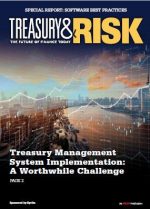Many companies are making treasury management systems a priority this year, and with  good reason. These solutions have the potential to improve cash forecasting, protect companies from fraud, and generally boost the efficiency of corporate treasury.
good reason. These solutions have the potential to improve cash forecasting, protect companies from fraud, and generally boost the efficiency of corporate treasury.
But actually implementing them can be more difficult than anticipated, especially for businesses that have never selected or used a treasury workstation. Treasury teams may find that if they do not plan carefully, they miss opportunities to get the most out of this crucial investment. Proper planning from the highest strategic levels to the most minute details can go a long way toward guaranteeing success.
Damien McMahon, a partner in the Financial & Treasury Management practice at PricewaterhouseCoopers, recounts his experience of working with clients who rush into implementation without considering what they really need from their treasury management system. According to McMahon, sometimes clients finish one part of an implementation only to find themselves out of time, over budget, or just plain overwhelmed.
“People get a bit exhausted, and then they implement just the basics with the promise that next year, when everyone has recovered, they'll implement all those bells and whistles they were dreaming about in the beginning,” says McMahon. “The only problem is that next year never happens—the next project comes along, and everyone is busy, and then when priorities shift, there is another [treasury management system] project again three years later.”
Bob Stark, vice president of strategy for cloud-based treasury management system Kyriba, says companies should engage in careful planning and analysis so that they reach consensus on the priorities and overarching goals of the implementation.
“It is critical for treasury to know what they need to get out of this, and at a strategic level,” Stark says. “The strategy needs to be there. If it's not, you get something that under-delivers. If you're looking to achieve success, it's important that you know exactly what success is.”
Indeed, Kyriba believes so strongly that strategic planning is vital to the implementation process that the company now has a value engineering team which specifically helps companies assess and quantify their goals, needs, and priorities, Stark explains. He says this part of the planning work should happen before the company gets into the details of what the treasury management system can do or timetables for implementation.
Adding the value engineering team has been a fairly recent shift for the company, Stark adds. “We formalized this process in the past two years because we recognized that successful project planning begins before the company purchases their [treasury management system]. We realized that it was far too easy for a treasury team to focus too much on their existing processes rather than thinking about what their end result really should be.”
Fitting the Pieces
So, how should a corporate treasury function decide on priorities? Elaine Filus, principal at consulting firm Treasury Strategies, says that even before talking to vendors, a treasury department should carefully examine everything it does, every day, and what it might improve. Filus has worked with some clients who take a week early in a treasury management system project to rethink every activity, every control, and every piece of information that feeds into treasury functions, whether it comes from another department within the company or from a far-flung bank. The goal of this evaluation is to understand how all the pieces fit together and how they could better work in concert.
“To the extent that you can think about your operation and what might not be particularly efficient now, and what you want to be better, the upfront planning can streamline the implementation itself,” Filus says.
Then companies can prioritize the items on their wishlist. Kyriba's Stark emphasizes that identifying what is most and least valuable to the organization goes a long way toward appropriately allocating energies and resources. “If you know the value to your organization of certain capabilities and certain requirements, it helps structure the implementation in the right way. You don't get distracted by other things that just don't deliver the same level of value.”
“It is critical for treasury to know what they need to get out of [the implementation], and at a strategic level.”
– Bob Stark, Vice President of Strategy, Kyriba
For example, Stark says, when a company realizes the value to be delivered by a reliable cash forecast, it then can further emphasize forecasting in the implementation and prioritize it in terms of the amount of resources dedicated to it. When that priority is widely understood, every other part of the project plan can map to that priority and fall into its place.
Delving into the Details
In addition to a high-level understanding of the overarching goals and strategy of a treasury management system implementation, experts agree that it should come with an abiding attention to the detail required. Indeed, treasury management system implementations are all about “detail, detail, detail, detail,” says PwC's McMahon.
From this bottom-up perspective, one key best practice is to get the right people involved from the start, those who can oversee the moving parts and help ensure that no important detail gets ignored.
Forrest Vollrath, executive director of treasury operations at Health Care Service Corporation (HCSC), advises that companies think in terms of three main categories—people, processes, and technology— as a framework for the implementation. His company won an Alexander Hamilton Silver Award in Treasury Transformation in 2015, for the enhancement of its cash management and forecasting processes through the implementation of a new treasury management system. “This will allow you to better organize the myriad of changes involved in the process,” Vollrath says. “The other piece of advice is to partner with all key stakeholders (upstreamand downstream) in the planning process.”
To begin with, usually, a project manager is chosen from the treasury team and is responsible for project governance. This is a key level of management and oversight that can make all the difference, says Jeff DiOrio, director, Treasury Strategies.
“The very best projects we see have very strong governance,” DiOrio says. “If there is strong project management and strong governance, it's very clear what people need to get done, and they know when it's due, and they also understand what's going to happen if they don't get it done.”
Most corporate treasury departments assign project management duties in a treasury management system implementation to someone within treasury, says Kyriba's Stark. Aside from the largest organizations, most corporate treasuries also prefer to work closely with
the vendor, rather than waiting for a socalled turnkey solution that is delivered ready-for-use, Stark says. “There is no one way in terms of allocation of internal resources. It depends on availability, costs, and time required. It's almost like an algebraic equation. But all of these decisions need to be made at the start so it's agreed upon regarding who is going to deliver all of these milestones and tasks within the project plan.”
Stark notes that other important people who need to be on board at the beginning of a treasury management system project are “power users,” individuals who will be using the system every day, and subject matter experts from departments such as accounting, payments, or financial planning and analysis (FP&A). They may have an important piece of information to deliver, or may need to weigh in on controls and approvals. Remembering to involve other groups or teams who use the data, contribute key figures, or are responsible for signing off on certain thresholds or controls is critical. “Coordination across functional groups has to be taken into account,” Stark says.
Thinking Realistically
When it comes to planning dates and deliverables, treasury teams need to be sure to avoid certain pitfalls, Stark says. The first is resourcing, and the important thing here is to be realistic about expected and unexpected events, like vacations, sick days and snow days, and even blackout periods. Consider, too, vacations abroad, which often are three weeks at least, Stark says. “We find especially with multinationals, if they have a European treasury center, scheduling objectives in late July or early August may not be the best idea. It's understanding the realities.”
Important, too, are easy-to-overlook communication glitches such as time zones in Asia, or when bank systems undergo a blackout period that freezes project implementation and testing. These may be small details, but “being realistic is incredibly important,” Stark says. “In the end it's a key component of a project.”
Testing is another critical aspect of a treasury management system implementation that companies tend to underestimate at the outset. “Build in time for testing,” Stark urges.
And not just one type of testing, says DiOrio of Treasury Strategies. Make sure testing is rigorous enough to include user acceptance testing, interface testing, and—at the last stage—parallel testing before the old system turns off, he says. “The goal is not testing for testing's sake, it's testing to make sure that when you go live, [the system] functions the way you want it to,” DiOrio says.
It could very well be that treasury departments have to rethink the timetable for treasury management system implementation after carefully considering all aspects of what will be required. It is not unusual for an implementation to take a full year, or even two, experts point out.
“Most people underestimate how long it is going to take to implement a treasury management system,” says McMahon. “That is because they haven't gone to the right level of detail.”
A Worthwhile Challenge
The good news for treasury departments is that implementing a treasury management system is a challenge which may have immeasurable payoff in efficiencies and protections, when done correctly. The keys to success are to plan early and well, and to stay focused on the priorities and the carefully crafted project plan that all relevant parties have agreed to.
Treasury teams should also work with their chosen vendor to keep the project focused on their end goal, says Stark. “Especially in treasury, it's easy to get pulled away in a different direction because treasury is such a lean organization,” he says. “It's difficult to stay focused all the way through a treasury management system implementation, because a lot of times, treasury is in a fire drill. That's where good project planning and governance are really important, so on those really difficult days, you don't lose time or lose focus. If you plan your implementation properly, and execute it properly, those sorts of things won't happen.”
Given the need for companies to limit fraud, and the constant pressure to do more with less, this year may well be a banner one for treasury management system implementations, according to data from Treasury Strategies published earlier this year. In January, more corporate treasurers told the consultancy that they were making treasury management systems a priority than did so in either 2017 or 2016.
“The other piece of advice [for a successful implementation] is to partner with all key stakeholders (upstream and downstream) in the planning process.”
– Forrest Vollrath, Executive Director, Treasury Operation, HCSC
Also from this Special Report
- SPONSORED STATEMENT: Best Practices in TMS Implementation
© Touchpoint Markets, All Rights Reserved. Request academic re-use from www.copyright.com. All other uses, submit a request to [email protected]. For more inforrmation visit Asset & Logo Licensing.




